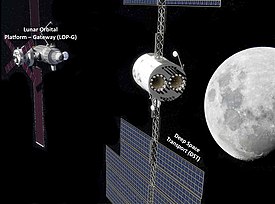 DST would comprise an Orion spacecraft and a propelled habitation module | |
| Mission type | Crewed Mars orbiter |
|---|---|
| Operator | NASA |
| Mission duration | 1–3 years |
| Spacecraft properties | |
| Launch mass | 100 metric tons[1][2][3] |
| BOL mass | Habitat: 48 tons (includes 21 tons Habitat with 26.5 tons cargo[1]) Electric propulsion system: 24 tons[1] Chemical propellant: 16 tons[1] |
| Start of mission | |
| Launch date | Suggested shakedown: 2027[4] Potential Mars launch: 2037[5] |
| Rocket | Space Launch System (SLS) |
| Launch site | LC-39B, Kennedy Space Center |
| Transponders | |
| Band | Dual: radio and laser comm[4][6] |
| Bandwidth | Ka band[6] |
The Deep Space Transport (DST), also called Mars Transit Vehicle,[6] is a crewed interplanetary spacecraft concept by NASA to support science exploration missions to Mars of up to 1,000 days.[4][2][7] It would be composed of two elements: an Orion capsule and a propelled habitation module.[3] As of late 2019, the DST is still a concept to be studied, and NASA has not officially proposed the project in an annual U.S. federal government budget cycle.[5][8][9] The DST vehicle would depart and return from the Lunar Gateway to be serviced and reused for a new Mars mission.[2][10][11]
- ^ a b c d Deep Space Transport (DST) and Mars Mission Architecture. (PDF) John Connolly. NASA Mars Study Capability Team. Published: October 17, 2017.
- ^ a b c Neel V. Patel. NASA Unveils the Keys to Getting Astronauts to Mars and Beyond. The Inverse. April 4, 2017.
- ^ a b Michelle Rucker, John Connolly. Deep Space Gateway – Enabling Missions to Mars – Shakedown Cruise Simulating Key Segments of Mars Orbital Mission. Mars Study Capability Team (2018). NASA.
- ^ a b c Eric Berger. Finally, some details about how NASA actually plans to get to Mars. ARS Technica. March 28, 2017.
- ^ a b Jeff Foust. Independent report concludes 2033 human Mars mission is not feasible. Space News. 18 April 2019.
- ^ a b c Cite error: The named reference
Free 2017was invoked but never defined (see the help page). - ^ Deep Space Transport approaches the Deep Space Gateway. The Planetary Society.
- ^ Philip Sloss. Cislunar station gets thumbs up, new name in President’s budget request. NASA Spaceflight. March 16, 2018.
- ^ Philip Sloss. NASA evaluates EM-2 launch options for Deep Space Gateway PPE. NASA Spaceflight. December 4, 2017.
- ^ Hambleton, Kathryn (March 28, 2017). "Deep Space Gateway to Open Opportunities for Distant Destinations". NASA. Archived from the original on September 27, 2017. Retrieved March 31, 2017.
- ^ Gatens, Robyn; Crusan, Jason. "Cislunar Habitation & Environmental Control & Life Support System" (PDF). NASA. Archived from the original (PDF) on March 31, 2017. Retrieved March 31, 2017.